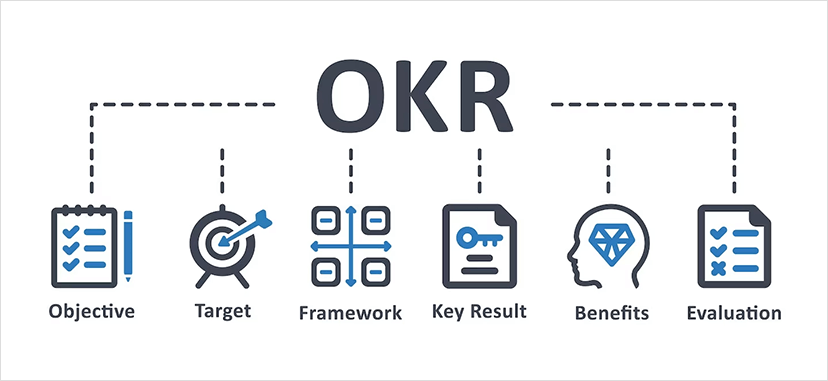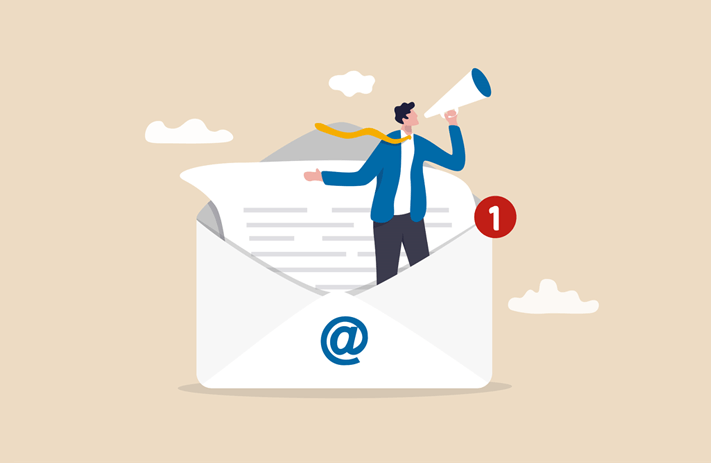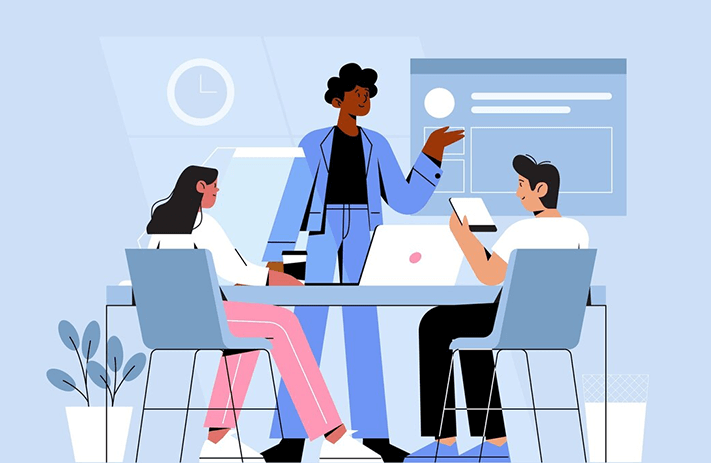
Click the button to start reading
How to Use OKRs to Fast Track Success (With Examples!)
Have you ever watched a business scale and achieve huge success, seemingly overnight? It’s hard to not to marvel and wonder, “How did they DO that?!
Because oftentimes, within our own organizations, it’s a different story entirely. Maybe it’s patterns of long meetings where everyone makes themselves part of the problem, not the solution, a disengaged workforce that makes a beeline for the door when the clock strikes five, resources squandered on products that fall flat, or marketing campaigns that never launch. But it’s so common to be caught up in a lot of busyness and in the long haul accomplish nothing meaningful.
You probably have a clear vision for your organization, a vision to scale, to develop innovative products, to meaningly engage with customers on social media. But as we’ve all come to see, getting there is the hardest part.
Many organizations have come to see that progress is determined by the quality of the goal. And these same organizations have discovered that a system known as OKRs is the secret formula to move the needle, to effect change and to realize dreams. Let’s drill down into the methodology behind OKRs, look at some examples, and go over tips for working them into an organization.

OKRs: A Definition
“OKRs” is an acronym that stands for “objectives and key results.” It’s an approach to goal setting that identifies both what to achieve and how to get there.
Andrew Grove, Intel’s third CEO, isn’t only famous for his mantra that “only the paranoid survive.” He is also credited with conceiving of the OKR methodology. In the 70s, he taught the process in management courses, calling it Management by Objective. The concept captivated Intel salesman John Doerr, who in his succeeding position at Google, introduced the idea to the company. The method caught on rapidly. Larry Page in fact credits Google’s fantastic success to OKRs. As he writes in the introduction to John Doerr’s book, Measure What Matters,
“OKRs have helped lead us to 10x growth, many times over. They’ve helped make our crazily bold mission of ‘organizing the world’s information’ perhaps even achievable. They’ve kept me and the rest of the company on time and on track when it mattered the most.”
Popularized by other books such as Christina Waodtke’s Radical Focus, OKRs have been used by individuals within an organization, teams, departments, entire organizations, and even for personal goals. They’ve been integrated into the management methodology of many successful organizations, including Github, Twitter, Linked in and Uber.
The Three Components to OKRs
From SMART goals to the agile methodology, there are all sorts of systems and approaches to productivity and goals setting. Just what makes OKRs distinct from the rest?
This simple method breaks a goal down into three tiers: objectives at the highest tier, key results in the middle, and tasks at the lowest.
1. Objective
The first component to an OKR is the objective. A good objective meets several criteria. It first of all aligns with the company’s mission and culture. Secondly, it’s aspirational and enthuses a team or individual. It’s also measurable and time bound. The objective should be achievable, but not too easy: it’s a stretch goal. It’s not a one-off activity, but it aligns with the objectives of the entire organization. An objective is usually a problem that needs to be solved, a change that needs to be made, or a desired outcome.
One objective, for example, might involve increasing sales. Simply stating “increase sales” however, is too vague. Nor is it time bound or aspirational. An effective objective, rather, might be to “rally the sales team to increase sales by 15% in the third quarter.” This adds some specificity and enthusiasm to the objective.
2. Key Results
Key results are the second component to OKRs. These are the “how” of the method and determine whether or not the objective has been achieved.
Generally, one objective has three to five key results that provides a focused path to achieving the objective. Key results describe outcomes, not activities. A good key result is time bound, specific, and includes a number.
It’s easy to tell if a key result has been achieved. As Andy Grove puts it: “The key result has to be measurable. But at the end you can look, and without any arguments: Did I do that or did I not do it? Yes? No? Simple. No judgments in it.”
For example, a key result might be to earn ten thousand followers on a social media account within a quarter. A simple glance at the social media account at the end of the period determines whether or not this result has been achieved.
3. Tasks
And finally, the tasks are all the activities needed to achieve the goal. For example, achieving a social media following of 10,000 might entail taking photographs, producing videos, posting a certain amount of content each week, and engaging on the platform for a period of time each day.
Committed and Aspirational OKRS
OKRs fall into two categories, committed and aspirational.
A committed OKR, as its name suggests, is one that the team commits itself to achieving. In a sense, a swarming effect takes place around a committed OKR. The team orients around this objective, tweaking schedules and allocating resources specifically to it. A committed OKR is considered easily achievable, and it only brings moderate improvement to a company or to systems.
An aspirational OKR is more like a BHAG (Big, Hairy Audacious Goal). It’s a risky endeavor and a shot for the moon. Aspirational OKRs can’t be written in the SMART format, because oftentimes there’s no clear steps to achieving them. Although an aspirational OKR may not be achievable, when it is, the results are significant. Many companies aim to complete a plurality of its aspirational OKRs, but they don’t anticipate achieving all of them.
A Few Formulas
A good OKR is brief. The objective and each key result generally is stated in fewer than twenty words. Oftentimes, they’re formatted in a simple phrase such as: “I will (objective) as measured by (key result).” Another way to formulate an OKR is with the equation: OKR = (Objective = “What”) + 3 x (Key Results = “Hows”)
With this brief recap of OKRs, let’s now look at some guidelines for how to create good ones.

Guidelines for Writing & Executing OKRs
An OKR is more than just writing a goal. It’s a system, and a lot of its success is determined by how they’re written and executed. These three guidelines help to facilitate success with OKRs.
Concise & Clear
OKRs are all about focused action. And so when an objective or key metric is long and wordy, the action isn’t clear, and neither is the outcome. A good OKR, then, needs to be sweet and to the point. An objective generally is fewer than twenty words, even. And a lot of business jargon or complicated business terminology doesn’t help. Rather, good objectives and key metrics are written at a 5th grade reading level.
Transparent
An OKR isn’t like a diary or a journal. It’s not something you write then hide under your keyboard, hoping that nobody from the office ever finds out what you’re working to achieve.
Rather, OKRs are fully exposed and out in the open.
When a goal is transparent, the accountability factor comes in. A team or individual is more driven to hold to their word and do what they say when everyone else knows what they’re working toward.
To achieve this visibility within remote teams, it’s a good idea to post OKRs within group chats on a project management software.
Short Time Frame Over the Long Time Frame
In the same way that a Gantt chart isn’t an effective way to plan an 18 month project, an OKR isn’t always suitable for long-term goals. As the time frame of a goal increases, it becomes more difficult to quantify and estimate. Rather, a small goal set for a short time frame is easier to break down and to create accurate estimates around timelines and resources.
And with these guidelines in mind, let’s turn to a few of the key benefits that OKRs provide to individuals and organizations.

The Benefits of OKRs
Some say that OKRs are like knowing a short cut, or having the tools to pick the lock. It’s a powerful way to capture success, fix problems and realize dreams both for individuals or organizations. Here are a few benefits they provide.
1. Prevents Cognitive Overload
In an organization that uses the OKR method, middle managers aren’t pummeled with information day in and day out. The method creates a focused environment where people work on those tasks that are going to move the needle and make an impact. It really creates a “more with less” dynamic where an organization progresses without stretching itself thin.
2. Creates a Transparent Culture
When OKRs are posted and out in the open, it creates a culture where everyone understands what everyone else is working towards. It’s a transparent culture where the values and expected actions are clear; the complete opposite of a toxic culture that thrives on competition and gossip.
3. Uses Resources Efficiently
OKRs identify where to put energy. Gone are the days of burning through a budget and scarce resources toward an objective that leads to nowhere. Rather, OKRs pinpoint the right action to take. It’s the most efficient way to get an organization from a current state to a desired future state.
OKRs echo the agile concept of identifying what most adds value to an organization, then focusing on that. It benefits organizations in so many ways. With this in mind, let’s look at some examples of OKRs for a variety of departments, and even in life!

8 Examples of OKRs
OKRs naturally vary depending on the department, the culture and the goals of the organizations. But they all bear a few similar characteristics across the board. Let’s take a look at some OKRs in a variety of contexts, both within an organization and in life. But first off, let’s evaluate three objective statements and identify those that fulfill the criteria of an OKR.
- Reduce turnover by 20% overall in the next five years.
- Introduce two innovative products to the line in Q1 and Q2.
- Survey customers to assess satisfaction rate.
Which objective doesn’t make the grade? It’s the third, because it doesn’t provide any metrics, making it difficult to assess whether or not it’s really been met. The other two are better, although the first has a long time frame. The second then, is probably the best. It inspires creative thinking and is set for a shorter time frame.
Now let’s look at some examples of OKRs.
1. Lifestyle & Personal Development
OKRs don’t only work within organizations. The principles apply in all aspects of life. Let’s consider two personal OKRs.
Personal Fitness OKR
Objective:
Improve overall health and well-being in Q1 and Q2.
Key Results:
- Incorporate vegetables into every meal.
- Improve cardio level by decreasing the time it takes to run a mile by one minute.
- Take time for rest and relaxation, and finish reading two fiction books.
Tasks:
The tasks to complete these key results can vary, but may include things like purchasing vegetables at the grocery store each week, researching recipes and planning meals, signing up for a gym membership, and purchasing two books of fiction.
Parenting OKR
Objective:
Improve communication skills with my children over the next six months.
Key Results:
- Learn child psychology by reading three books on the topic.
- Develop three methods for discipline and encouragement.
Tasks:
The tasks around these key results might include things like speaking to other parents, researching and purchasing three books, and “trying things out” with your children.
2. Professional Development
Objective:
Transition into a position with more lifestyle flexibility within twelve months.
Key Results:
- Outline the characteristics of the ideal position, with respect to pay, vacation, personal time and remote work options.
- Research companies with good work-life balance cultures, and identify ten suitable companies.
- Apply for ten positions in Q1 and Q2.
Task:
The tasks might include things like taking an intensive interview-training course, reading online articles and listening to podcasts about the best companies to work for, speaking to colleagues and professional contacts, reading about the options out there, and possibly meeting with a career coach.
3. Marketing
Objective:
Reduce bounce rate at the company website by 20% in six months.
Key Results:
- Add ten pieces of long-form content around evergreen topics in the industry.
- Improve website usability by adding drop-down menus.
- Add video to the home page, welcoming users and explaining the benefits of your service.
Tasks:
The tasks around this objective entail things like hiring a software developer to reformat the website, hiring a video team, researching good topics for content and then writing copy.
4. Operations
Objective:
Reduce output time by 10% in Q1.
Key Results:
- Study current processes and systems, breaking them down into individual tasks and calculating the average time for each task.
- Identify bottlenecks and add resources to these stages in the workflow.
- Incorporate kanban boards into teams to develop a pull workflow.
Tasks:
The tasks for this OKR might include things like creating a map that lists the current workflow, training the team in how to use kanban boards, and hiring or purchasing additional resources for stages that experience frequent bottlenecks.
5. Human Resource
Objective:
Implement an offboarding process in Q1 that aims to retain positive relationships with former employees.
Key Results:
- Start a newsletter to send to former employees that keeps them abreast of current happenings in the organization.
- Provide a perk to former employees, such as access to the organization’s services for a period.
- Demonstrate appreciation to departing employees with a farewell party.
Tasks:
The tasks for these key results include things like hiring a copywriter for the newsletter, compiling an email list of former employees, and identifying a perk to provide to outgoing clients.
6. Customer Relationship Management
Objective:
Increase online reviews from 4/5 to 4.5/5 by Q4.
Key Results:
- Send follow-up emails to current clients, encouraging them to provide a review.
- Identify current areas of weakness and strength by sending out a survey to current customers.
- Train the current staff in protocol and best practices around customer service expectations.
Tasks:
Tasks around these key results might be things like developing the survey, studying the survey, developing clear customer service protocol and setting up a training session.
7. Company Culture
Objective:
Improve rapport and employee engagement over the first three quarters.
Key Results:
- Create a position dedicated to employee experience.
- Create a virtual break room in the project management software platform and hold weekly activities, such as AMAs for a designated employee.
- Hold an appreciation meeting each quarter that acknowledges the contributions of key employees and teams.
Tasks:
This objective might include things like outlining the position and its duties, conducting interviews, planning the appreciation meeting and determining how to acknowledge individuals at the meeting.
8. Finance
Objective:
Increase sales over the busy holiday season by 15%.
Key Results:
- Hire seven additional staff members to speed up order processing times.
- Order two times the normal inventory.
- Run an advertising campaign on three social media accounts.
Tasks:
The tasks around these key results would mean that HR doubles down and hires more employees, procurement orders more inventory, and marketing develops content around the holiday sale.
As you can see, OKRs can be adopted to suit any area within an organization, as well as be used in personal life. The three-tiered approach creates a logical and clear connection between an objective and the daily activity.

8 Tips to Succeed With OKRs
OKRs promise a lot to an organization and an individual. As demonstrated by companies like Google and Intel who adopted them, the results are remarkable. But simply writing a good OKR doesn’t mean the vision is realized. To this end, here are eight tips to keep an OKR on track and to achieve the results they promise.
1. Be Prescriptive
An OKR is a management system that an organization adopts into its current way of doing things. And as with any new system, it most definitely encounters resistance to change. People want to remain in familiar grooves of doing the same old things every day. And so when first implementing OKRs into an organization, there’s a strong tendency for people to phone things in. Or they may underperform simply because they don’t understand what OKRs are all about.
In order to create new habits and routines, it’s helpful for a leader to provide detailed guidance to teams and individuals. If the OKR begins with an initial meeting, explain what points to cover in the meeting, and what output is expected from each attendee. If attendees are expected to participate in daily check-ins or periodic retrospectives, explain what each of these processes look like, outlining the length and the various roles of attendees, and the expected outcomes.
This might seem authoritative, but it really isn’t. People need clear directives when learning something new. When people see the specifics laid out, they’re far more likely to follow the leader into the new system.
2. Build a Resource Center
If an organization wants its members to write good OKRs, one central step is to provide the tools and means to do so. A resource center, ideally on the company website, or in literature distributed throughout the company, can serve as a go-to for anyone wanting to learn more about the process.
A good resource center describes the methodology, then provides examples and step-by-step templates for building an OKR, including the objectives and key metrics. A training university that provides certifications ensures that everyone receives comprehensive instruction on the method and keeps everyone in the company on the same page.
3. Build the Community
Evangelization is one of the key methods to adapting OKRs into an organization. This in part means getting leadership on board to model the enthusiasm and expectations. Strong leadership sets the tone. It holds teams accountable to setting OKRs, sharing them, and then following through. Sometimes just a small group of vocal OKR enthusiasts is enough to sway the naysayers and convert the skeptics.
Disseminating the story not only entails shaping the right message, but also utilizing the right tools. Good communication methods such as newsletters, speakers and monthly meetups around creating and executing OKRs helps to integrate the method into the company’s culture.
At this stage, getting upper management on board is key. This allows managers to communicate the benefits of the change directly to employees.
4. Use Data to Monitor and Optimize Outcome
Any good OKR includes metrics and specifics. This is largely why they’re effective. And so monitoring them means looking at data. A good execution includes periodic check-ins that consider where you are and where you want to be. It’s like a burndown chart in a sense: if the goal is to sell 1,000 widgets in a quarter, then data can demonstrate how far the team has come toward achieving this goal.
Of course, the progress on most OKRs isn’t so easy to measure as in the example mentioned above. With an OKR to “increase employee engagement,” for example, it is more challenging to find meaningful metrics to identify whether or not the company has achieved the goal.
In any OKR, however, the key is to find a way to measure the baseline (where the situation stands at implementation) and where it wants to be at the future date. The next step is to hone in on a metric or metrics that serve to really move the needle and advance this objective.
Aspirational and committed OKR obviously have differences with respect to data. With a committed OKR, it is much easier to pinpoint concrete data and determine if it’s completed at the end.

5. Analyze & Audit OKRs
Particularly within a large organization, it’s common for individual departments to work within silos. They hunker down, put on their blinders, and take care of business. And so two departments might write nearly identical OKRs without realizing that they’re both working toward the same goal.
Taking a step back to look at the big picture allows things to line up. Rather than one department working on building rapport, for example, it can become a cross-department endeavor. Panning out helps to identify redundancies, create synergy, and ultimately save resources.
At the same time, an OKR is only as good as the way it’s written. Nobody wants to spend two quarters working toward an uninspiring, nebulous objective. Having a leader take the time to survey the OKRs created by a team and then to rate them (say on a scale of 1-5), sets a bar. It prevents fuzzy, wordy objectives from entering into the fray. Even a simple word count requirement on objectives (for example, any objective over 25 words needs to be rewritten) creates a benchmark that ensures quality OKRs.
6. Study Effective Teams
Some groups take off with OKRs and it’s like a spaceship launched. While with other teams, the method sputters and stalls. A little tweak can make all the difference between an effective team and a poor one. Skipping a retrospective, for instance, inhibits growth and improvement within processes.
Taking the time to study how an effective team functions, compared with the lesser effective ones, helps to identify the rubrics of succeeding with OKRs.

7. Adopt Agile Principles
It’s pretty clear to anyone who works with OKRs and agile that the two methodologies have a lot of overlap. Both seek to clear away busywork, and align energy and resources around what is going to really add value to an organization, project, endeavor or campaign.
At the same time, agile incorporates a lengthier set of principles than OKRs. And effectively implementing OKRs means borrowing on a few of these.
Autonomy. The agile team functions as an autonomous group within an organization. They set their own objectives, timelines and sprints. Allowing teams and individuals to set and monitor their own OKRs increases the intrinsic motivation inherent with the method.
Openness to Change Over Following a Plan. An OKR, after some time has elapsed, may come to seem senseless. And so a good team re-evaluates objectives periodically to see how they line up with the organization’s overall goals, and determines whether to continue on, readjust, or throw the goal out entirely.
Smaller Goals over Larger Ones. One popular activity in agile is planning poker. This uses the Fibonacci sequence of increasingly larger numbers to estimate the duration of tasks. The essential takeaway from this game is that a more complicated task becomes difficult to estimate. And so agile encourages breaking projects down into manageable chunks.
OKRs benefit from this same idea. A goal on a shorter time frame is easier to estimate and tackle than a long term goal.
8. Don’t Link to Pay
One of the main challenges to OKRs is that people see it as a performance evaluation. Ideally, an OKR is interiorly driven. It’s not a carrot and stick method implemented by the manager. And so linking an OKR to a bonus, for example, can be counter productive. This reward shifts the motivation from intrinsic to extrinsic, and people lose their internal motivation.
A good OKR really is about empowering people to solve their own problems. And so making them an independent endeavor, to the exclusion of other metrics in the company, helps to ensure this.
Conclusion
It’s common to get caught up into patterns of setting goals that aren’t working, of working to scale a company with little success. If you feel like your company sometimes wanders, directionless, or like it’s stuck at the end of a cul-de-sac, then maybe the problem is your goal-setting method.
For many, OKRs are the solution to getting a company from its current state into a desired future state, and even to achieving the seemingly impossible.
Whether for an individual or a team or an entire organization, OKRs promise to focus energy and conserve resources. They reduce brain clutter and improve mental clarity.
Although the formula is very simple, its secret is to use metrics and to align tasks around what is going to add value. So anyone who’s got a hankering to succeed should keep this handy tool in the tool box.
















